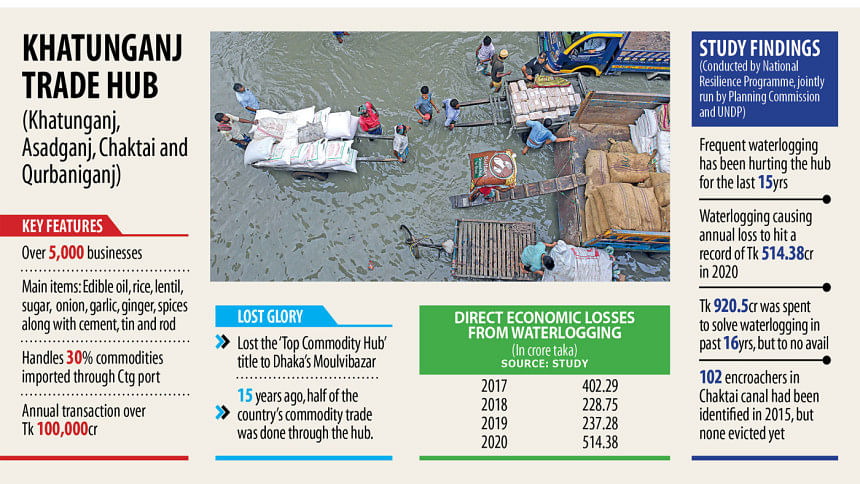Khatunganj lost over Tk 514cr to waterlogging in 2020: study

Traders in Chattogram's Khatunganj incurred direct financial losses of around Tk 514.38 crore last year solely for waterlogging, estimated a study made public yesterday.
The damage occurred not only to stocks of the country's once top commodity trading centre and commercial hub but also through reduction in sales.
There was also damages to infrastructure and properties, loss of capital assets, cost of repairment and renovation and relocation of business cost.
Some of the non-financial impacts include mental trauma, anxiety or psychological pressure, demotivation of doing business and reputational damage, the study found.
It feared that with changes in climatic conditions, such estimated economic impact would be even higher with time if no effective solution is undertaken.
The study suggested for regular dredging facilities for the Karnaphuli river and Chaktai canal and ensuring responsible waste management practices by the traders to get rid of the problem.
The report was the culmination of a yearlong research titled "Study on economic Impact of Waterlogging on Local Trade: The Case of Khatunganj, Chattogram".
The study was conducted by Associate Prof AKM Nazrul Islam, coordinator of Environmental Economics Programme of the Dhaka School of Economics; urban meteorologist Senior Assistant Prof Abu Taib Mohammad Shahjahan of American International University Bangladesh and Prof Md Reaz Akter Mullick of the Department of Civil Engineering of the Chittagong University of Engineering and Technology.
The three acted as consultants of a project of National Resilience Programme (NRP), which was run by Programming Division of the Planning Commission, funded by United Nations Development Programme and initiated and supervised by the CCCI.
The study was presented at a seminar organised by the Chittagong Chamber of Commerce and Industry (CCCI) at Bangabandhu Hall of World Trade Centre in the port city.
Chairing the event, CCCI President Mahbubul Alam said the age-old commodity trading hub on the banks of Chaktai canal has been facing frequent waterlogging for the last 15 years.
Chattogram City Corporation (CCC) Mayor Rezaul Karim Chowdhury as chief guest urged for a platform to work in a coordinated manner to solve the problem not only for Khatungnaj but the city as well.
The platform could be formed under the CCC comprising all the relevant organisations like Chittagong Development Authority, Chattogram Port Authority (CPA), Wasa and Water Development Board, he said.
Addressing as special guest, Planning Commission Programming Division Chief Khandker Ahsan Hossain said the government was giving priority to such studies so that the risk management factors could be learnt which would help make private sector investments more sustainable.
The study found that low rainfall of around 75 mm per day leads to a water level of 2.5 metres at the Chaktai canal.
Meanwhile average rainfall generates a water level of 3 to 3.5 metre resulting in inundation at Khatunganj. Compared to it, the area's main road is about 2.9 to 3.1 metre.
An average rainfall of 125 mm a day creates water inundation of about 6 inches to 1 foot over the main road while a heavy rainfall of 200 mm a day with a climate change scenario gives around 4.1 metre water level, meaning around 1 meter depth of water inundation on the road.
All the 224 structures on both sides of Khatunganj main road become vulnerable on a day of heavy rainfall.
The study recommended revitalising the Chaktai canal by demolishing all RCC works from the bottom of it and widening the canal to allow adequate flow of water to revive biodiversity.
It stressed the need for revitalisation and reconnection of water-based transportation in the supply chain by reactivating Chaktai canal by demolishing current bridges over it and construct a new bridge allowing vessel navigation underneath.
Other recommendations include creating a multimodal transport hub to integrate road connection with the waterway and setting up a "waste to energy plant" to manage solid waste at the city and on a local scale.
It called for taking proper planning on land use to maintain water retention areas in the canal catchment and to increase water retention capacity of Chaktai canal by dredging and by widening roadside drains to keep the canal free from blockage.
Analysing the land at the site, currently building structures cover around 55 per cent of the whole area where water storage capacity in terms of water bodies covers only 7 per cent.
To get rid of waterlogging the study recommends to increase water holding capacity to 52 per cent and to reduce building structure in the area to 46 per cent.

 For all latest news, follow The Daily Star's Google News channel.
For all latest news, follow The Daily Star's Google News channel. 



Comments